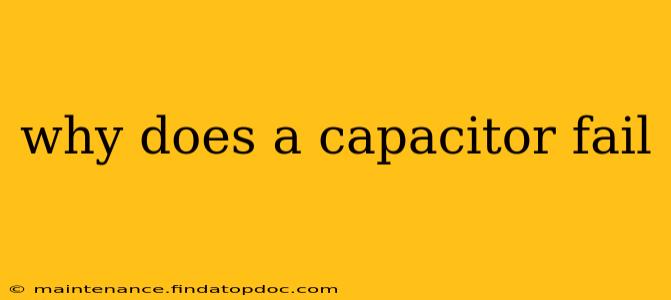Why Does a Capacitor Fail? Understanding Capacitor Failure Mechanisms
Capacitors, essential components in electronic circuits, store electrical energy and are crucial for various functions. However, like all electronic components, capacitors are susceptible to failure. Understanding the reasons behind capacitor failure is vital for troubleshooting and preventing malfunctions in electronic devices. This comprehensive guide explores the common causes of capacitor failure, helping you diagnose issues and maintain the health of your electronic systems.
What are the Common Causes of Capacitor Failure?
Several factors contribute to capacitor failure. These can be broadly categorized as:
-
Dielectric Breakdown: This is perhaps the most common reason for capacitor failure. The dielectric material, the insulating layer between the capacitor plates, can be compromised due to excessive voltage, temperature, or aging. When the dielectric breaks down, it allows current to flow between the plates, shorting the capacitor and potentially damaging other components in the circuit. This can manifest as a complete loss of capacitance or a short circuit.
-
Overvoltage: Exceeding the capacitor's rated voltage is a major cause of failure. Applying a voltage higher than the capacitor's maximum working voltage (WV) stresses the dielectric, increasing the risk of dielectric breakdown. This is often seen in power supply circuits where voltage spikes or surges can occur.
-
Overheating: Excessive heat can degrade the dielectric material and other internal components of a capacitor. Prolonged exposure to high temperatures accelerates aging, making the capacitor more prone to failure. Poor heat dissipation in densely packed circuits or inadequately designed power supplies can lead to overheating.
-
Electrolytic Capacitor Degradation: Electrolytic capacitors, commonly used in power supplies and filter circuits, have a limited lifespan. The electrolyte inside these capacitors can dry out over time, reducing their capacitance and increasing their equivalent series resistance (ESR). This can lead to reduced performance, increased ripple voltage, and ultimately, failure. The drying process is accelerated by high temperatures and continuous operation at high ripple currents.
-
Mechanical Stress: Physical damage to a capacitor, such as cracks in the casing or broken leads, can impact its performance. Vibration or shock can also contribute to internal damage, especially in electrolytic capacitors where the electrolyte can be affected.
What are the Signs of a Failing Capacitor?
Identifying a failing capacitor can be challenging, but some common signs include:
-
Bulging or Leaking: In electrolytic capacitors, bulging of the casing is a clear indication of internal pressure build-up, usually due to overheating or electrolyte drying. Leaking electrolyte is a more serious sign, requiring immediate replacement.
-
Changes in Capacitance: A failed capacitor may exhibit a significant change in its measured capacitance, either significantly lower or higher than its rated value.
-
Increased ESR: A high ESR value can indicate degradation or failure. This can be measured using a specialized ESR meter.
-
Unusual Noise: A failing capacitor can sometimes produce audible noise, humming, or buzzing, especially in power supply circuits.
How Can I Prevent Capacitor Failure?
Preventive measures can significantly extend the lifespan of capacitors:
-
Choosing the Right Capacitor: Selecting capacitors with appropriate voltage ratings, temperature ratings, and capacitance values for the specific application is crucial.
-
Proper Heat Dissipation: Ensuring adequate heat sinking or ventilation can help prevent overheating.
-
Surge Protection: Using surge protection devices can help mitigate the impact of voltage spikes and surges on the capacitors.
-
Regular Inspection: Periodically inspecting capacitors for physical damage or signs of bulging can help identify potential problems early on.
What are the different types of capacitor failures?
Capacitor failures can manifest in several ways, including:
-
Short Circuit: A complete short circuit occurs when the dielectric breaks down, allowing current to flow freely between the capacitor's terminals. This is usually catastrophic and can damage other components.
-
Open Circuit: An open circuit occurs when the internal connections or the dielectric are completely severed, resulting in the capacitor losing its ability to store charge.
-
Reduced Capacitance: Aging and degradation can lead to a decrease in capacitance, affecting the circuit's performance.
-
Increased ESR: As mentioned, an increase in equivalent series resistance (ESR) degrades performance and can ultimately lead to failure.
Understanding the causes and signs of capacitor failure is crucial for maintaining the reliability of electronic devices. By taking preventative measures and being aware of the symptoms, you can minimize the risk of failure and ensure the longevity of your electronic systems.
